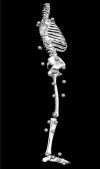The interaction of trunk-load and trunk-position adaptations on knee anterior shear and hamstrings muscle forces during landing
- PMID: 20064042
- PMCID: PMC2808754
- DOI: 10.4085/1062-6050-45.1.5
The interaction of trunk-load and trunk-position adaptations on knee anterior shear and hamstrings muscle forces during landing
Abstract
Context: Because anterior cruciate ligament (ACL) injuries can occur during deceleration maneuvers, biomechanics research has been focused on the lower extremity kinetic chain. Trunk mass and changes in trunk position affect lower extremity joint torques and work during gait and landing, but how the trunk affects knee joint and muscle forces is not well understood.
Objective: To evaluate the effects of added trunk load and adaptations to trunk position on knee anterior shear and knee muscle forces in landing.
Design: Crossover study.
Setting: Controlled laboratory environment.
Patients or other participants: Twenty-one participants (10 men: age = 20.3 +/- 1.15 years, height = 1.82 +/- 0.04 m, mass = 78.2 +/- 7.3 kg; 11 women: age = 20.0 +/- 1.10 years, height = 1.72 +/- 0.06 m, mass = 62.3 +/- 6.4 kg).
Intervention(s): Participants performed 2 sets of 8 double-leg landings under 2 conditions: no load and trunk load (10% body mass). Participants were categorized into one of 2 groups based on the kinematic trunk adaptation to the load: trunk flexor or trunk extensor.
Main outcome measure(s): We estimated peak and average knee anterior shear, quadriceps, hamstrings, and gastrocnemius forces with a biomechanical model.
Results: We found condition-by-group interactions showing that adding a trunk load increased peak (17%) and average (35%) knee anterior shear forces in the trunk-extensor group but did not increase them in the trunk-flexor group (peak: F(1,19) = 10.56, P = .004; average: F(1,19) = 9.56, P = .006). We also found a main effect for condition for quadriceps and gastrocnemius forces. When trunk load was added, peak (6%; F(1,19) = 5.52, P = .030) and average (8%; F(1,19) = 8.83, P = .008) quadriceps forces increased and average (4%; F(1,19) = 4.94, P = .039) gastrocnemius forces increased, regardless of group. We found a condition-by-group interaction for peak (F(1,19) = 5.16, P = .035) and average (F(1,19) = 12.35, P = .002) hamstrings forces. When trunk load was added, average hamstrings forces decreased by 16% in the trunk-extensor group but increased by 13% in the trunk-flexor group.
Conclusions: Added trunk loads increased knee anterior shear and knee muscle forces, depending on trunk adaptation strategy. The trunk-extensor adaptation to the load resulted in a quadriceps-dominant strategy that increased knee anterior shear forces. Trunk-flexor adaptations may serve as a protective strategy against the added load. These findings should be interpreted with caution, as only the face validity of the biomechanical model was assessed.
Figures





Similar articles
-
Hamstrings stiffness and landing biomechanics linked to anterior cruciate ligament loading.J Athl Train. 2013 Nov-Dec;48(6):764-72. doi: 10.4085/1062-6050-48.4.01. Epub 2013 Jun 14. J Athl Train. 2013. PMID: 24303987 Free PMC article.
-
Neuromuscular and biomechanical landing performance subsequent to ipsilateral semitendinosus and gracilis autograft anterior cruciate ligament reconstruction.Knee Surg Sports Traumatol Arthrosc. 2008 Jan;16(1):2-14. doi: 10.1007/s00167-007-0427-4. Epub 2007 Nov 1. Knee Surg Sports Traumatol Arthrosc. 2008. PMID: 17973098
-
The relationships among sagittal-plane lower extremity moments: implications for landing strategy in anterior cruciate ligament injury prevention.J Athl Train. 2009 Jan-Feb;44(1):33-8. doi: 10.4085/1062-6050-44.1.33. J Athl Train. 2009. PMID: 19180216 Free PMC article.
-
Contributions to the understanding of gait control.Dan Med J. 2014 Apr;61(4):B4823. Dan Med J. 2014. PMID: 24814597 Review.
-
Muscle Force Contributions to Anterior Cruciate Ligament Loading.Sports Med. 2022 Aug;52(8):1737-1750. doi: 10.1007/s40279-022-01674-3. Epub 2022 Apr 18. Sports Med. 2022. PMID: 35437711 Free PMC article. Review.
Cited by
-
Neuromuscular control in males and females 1 year after an anterior cruciate ligament rupture or reconstruction during stair descent and artificial tibial translation.Sci Rep. 2023 Sep 15;13(1):15316. doi: 10.1038/s41598-023-42491-6. Sci Rep. 2023. PMID: 37714980 Free PMC article.
-
Core-Muscle Training and Neuromuscular Control of the Lower Limb and Trunk.J Athl Train. 2019 Sep;54(9):959-969. doi: 10.4085/1062-6050-113-17. Epub 2019 Aug 6. J Athl Train. 2019. PMID: 31386583 Free PMC article.
-
Greater Breast Support Alters Trunk and Knee Joint Biomechanics Commonly Associated With Anterior Cruciate Ligament Injury.Front Sports Act Living. 2022 May 20;4:861553. doi: 10.3389/fspor.2022.861553. eCollection 2022. Front Sports Act Living. 2022. PMID: 35669558 Free PMC article.
-
Lower limbs kinematic analysis during a jump landing task in soccer players with unilateral anterior cruciate ligament reconstruction.BMC Sports Sci Med Rehabil. 2024 Oct 25;16(1):221. doi: 10.1186/s13102-024-01012-2. BMC Sports Sci Med Rehabil. 2024. PMID: 39456100 Free PMC article.
-
ACL Research Retreat VI: an update on ACL injury risk and prevention.J Athl Train. 2012 Sep-Oct;47(5):591-603. doi: 10.4085/1062-6050-47.5.13. J Athl Train. 2012. PMID: 23068597 Free PMC article. No abstract available.
References
-
- Krosshaug T., Nakamae A., Boden B. P., et al. Mechanisms of anterior cruciate ligament injury in basketball: video analysis of 39 cases. Am J Sports Med. 2007;35(3):359–367. - PubMed
-
- US Department of Health and Human Services, Centers for Disease Control and Prevention, National Center for Injury Prevention and Control. CDC Injury Research Agenda. http://www.cdc.gov/ncipc/pub-res/research_agenda/01_foreword.htm. Published June 2002. Accessed June 16, 2009.
-
- Beynnon B. D., Fleming B. C., Johnson R. J., Nichols C. E., Renström P. A., Pope M. H. Anterior cruciate ligament strain behavior during rehabilitation exercises in vivo. Am J Sports Med. 1995;23(1):24–34. - PubMed
-
- Shelburne K. B., Torry M. R., Pandy M. G. Muscle, ligament, and joint-contact forces at the knee during walking. Med Sci Sports Exerc. 2005;37(11):1948–1956. - PubMed
-
- DeMorat G., Weinhold P., Blackburn T., Chudik S., Garrett W. Aggressive quadriceps loading can induce noncontact anterior cruciate ligament injury. Am J Sports Med. 2004;32(2):477–483. - PubMed
Publication types
MeSH terms
LinkOut - more resources
Full Text Sources
Medical

